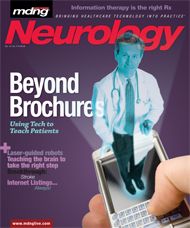Publication
Article
MDNG Neurology
Tech Tips: Uncle Sam Says "I Want You... to Use E-prescribing"
Fewer than one in five physicians use e-prescribing, resulting in a paltry 35 million electronically transmitted prescriptions each year.
Although the Centers for Medicare and Medicaid Services (CMS) and the federal government have long recognized the value of e-prescribing, physicians have been much slower to embrace the virtues of this technology. Fewer than one in five physicians use e-prescribing, resulting in a paltry 35 million electronically transmitted prescriptions each year (out of the 3.2 billion prescriptions written annually). In an attempt to reverse this poor adoption rate, the recently signed into law Medicare Improvements for Patients and Providers Act of 2008, which also delayed the planned 10.6% Medicare reimbursement reduction, calls for bonus payments for physicians who e-prescribe for their Medicare patients.
The new law also calls for financial penalties for physicians who refuse to use this technology. I think these bonuses and penalties show that the government is finally ready to put its money where its mouth is when it comes to e-prescribing. This is the first time the government has used such a carrotand-stick approach on a grand scale to facilitate the adoption of a new technology. The Pharmaceutical Care Management Association (PCMA) estimates this approach will result in about an 80% adoption rate over the next 10 years, potentially saving $26 billion. Other groups, including the Congressional Budget Office, believe that only financial penalties will promote greater adoption of e-prescribing and have proposed that participation in Medicare require EHR utilization.
Beginning January 1, 2009, CMS will provide a 2% bonus to physicians who use e-prescribing for their Medicare patients, two years later the bonus dips to 1% for two years, and the last year of the program (2013) off ers a 0.5% bonus. Beginning in 2012, failure to e-prescribe will result in a 1% deduction in Medicare payments for physicians who do not use e-prescribing, increasing to 1.5% in 2013 and 2% in 2014.
The program will be administered through the Physician Quality Reporting Initiative (PQRI)—the program that provides a 2% bonus for physicians who are in compliance with specified quality criteria. Incidentally, physicians may participate in both programs and receive a maximum 4% bonus if they qualify on both the quality and e-prescribing measures. Similar to the PQRI program, the e-prescribing bonus will likely be an end-of-the-year, lump sum payment.
Several issues remain regarding the program’s details. For example, previously approved legislation specifies the e-prescribing data format for Part D Medicare patients. Under these rules, a faxed prescription is not an acceptable format for prescription transmission and would not qualify as e-prescribing. How this will be affected by the new law is unclear. Currently standalone prescribing solutions, as well as e-prescribing, integrated into a more comprehensive EHR package will qualify for the bonus. Whether a standalone prescribing program will qualify for the duration of the program has not been defined. I suspect that e-prescriptions will eventually need to be generated from a CCHIT-certifi ed EHR in order to qualify for a bonus.
Finally, the status of the ability to e-prescribe controlled substances remains unclear. The DEA recently published a proposal (open to public comment until September 2008) that outlines the security infrastructure necessary to prevent narcotic “diversions” when electronically prescribing controlled substances. The DEA solution calls for rigorous security measures, including validation of the individual prescriber’s identity and credentials and the use of an external thumb-drive “crypto key” in order to generate each controlled substance prescription. At first glance, it appears that this proposal may satisfy stringent security requirements, but it would not help facilitate the adoption of e-prescribing. Even if this proposal gets adopted as is, some estimates say that it will take at least three years for the DEA to implement the system, meaning that during this time, there will still be a dual prescription process that does not facilitate the CMS goal of e-prescribing for all Medicare patients.
Dr. Zuckerman is an MDNG Healthcare IT Advisory Board member, and the Chief of Neurology and Medical Information Officer at Baton Rouge General Hospital in Louisiana.






